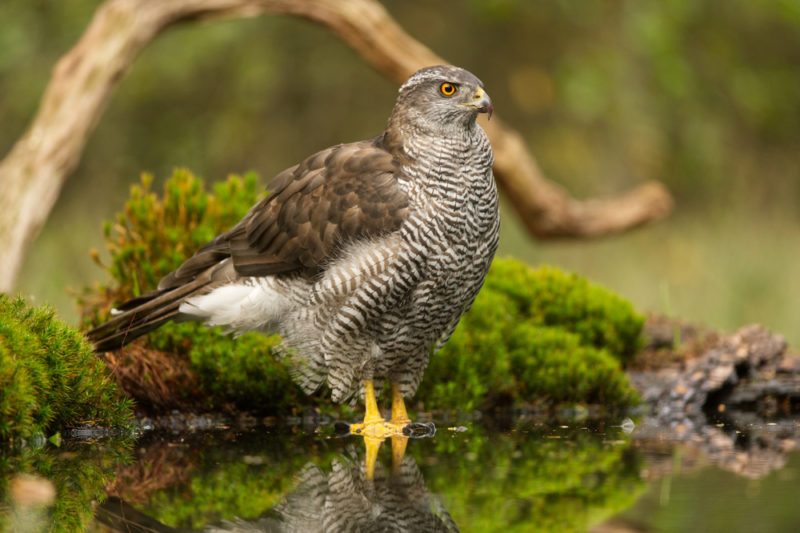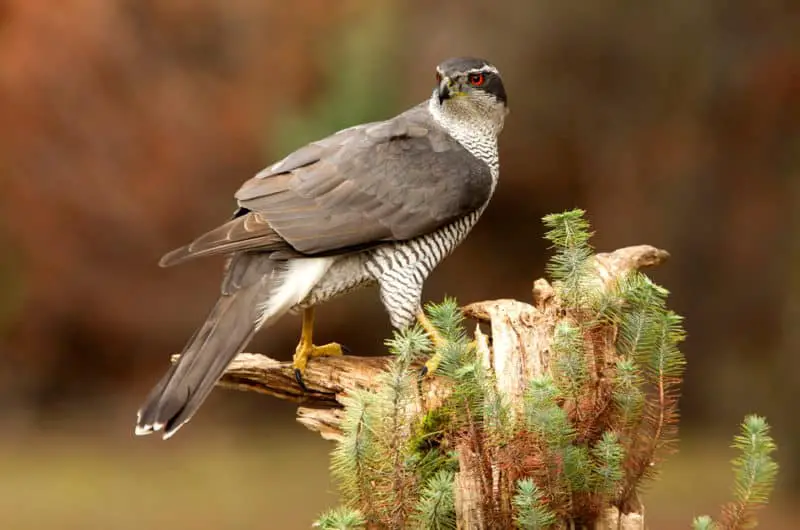Scientific Name- ” Accipiter gentilis“
Northern Goshawks are often known as goshawks without the northern modifier. They are a slate grey, medium-sized forest raptor. These birds have earned the title, phantoms of the forest due to their reclusive nature and their swift, stealthy flight through the dense forest when they’re on the hunt.
Northern Goshawks are endemic to both Eurasia and North America. They’re from the Accipitridae family, which also includes eagles, buzzards, and harriers. Additionally, they’re from the Accipiter genus. Other Accipiter genus members are also medium to small-sized hawks.
There are 3 North American accipiters of which the Northern Goshawk is the least numerous. The other 2 are the Sharp Shinned Hawk ” Accipiter striatus ” and the Cooper’s Hawk “Accipiter cooperii “.
Northern Goshawk Characteristics
The northern goshawk looks like a larger, fiercer version of a cooper’s hawk. They have evolved to be maneuverable through dense forests. Consequently, they have proportionately short, broad wings and a long wedge-shaped tail that they use as a rudder. This is typical of all Accipiter species.
Adults are blueish or brownish grey down their backs and on the top surface of their wings. Their underparts are light grey with horizontal black bars and vertical grey streaking. Additionally, their tails have alternating dark grey and light grey bands. The coloring of their head is black with a white eyebrow-like stripe over each eye. Adult northern goshawks have red eyes.
Adult northern goshawks weigh 1.5 to 2.6 pounds. Additionally, they are 18 to 26 inches long and have a wingspan of 40 to 46 inches.
These birds are moderately sexually dimorphic. An Average adult female northern goshawk will be larger than an average adult male. Also, females are usually browner than males.
The flight pattern of northern goshawks is similar to that of other accipiter species. It is characterized by a series of short, powerful wing beats followed by a short gliding period.

Characteristics of Juvenile Northern Goshawks
People sometimes confuse juvenile northern goshawks with adult red shouldered hawks “Buteo lineatus.” At first glance, they share some physical similarities. However Red shouldered hawks have more rounded wings, pale crescents within the wing, and shorter tails.
Juvenile plumage of northern goshawks is brown on top with white mottling. The crown of their head is brown. They have whitish eyebrow marks that are less distinct than those on an adult bird. What’s more, they have cream-colored underparts that are streaked with brown.
The irises of a juvenile bird are orange, whereas those of an adult are red.
Northern goshawks attain their adult plumage and eye color after their second year.
Northern Goshawk Range
These birds predominantly inhabit the northern temperate forests and boreal forests in North America, Asia, and Europe.
In North America, the largest populations of them breed in coniferous, deciduous, and mixed coniferous and deciduous forests in southwest Alaska and Canada. There are also fragmented year-round populations of them in the contiguous 48 states of the U.S. They are most heavily concentrated in the western states. There are breeding populations from Washington south to southern California. Breeding populations exist in the Cascade and Sierra Nevada ranges in the west. Eastward they also live in the foothills of the Rocky Mountains. There are also isolated breeding populations in the southwestern United States in New Mexico, Arizona, and West Texas, then south into western Mexico in Sonora, Chihuahua, Jalisco, and Guerrero. And the northeast in the lower 48 states.
There are also breeding populations of northern goshawks in the western Great Lakes region states of Illinois, Ohio, Minnesota, and Michigan.
Some northern goshawks remain in the same location year-round, while others migrate south for the winter. It depends on the availability of wintertime prey. These birds are what are termed eruptive migraters. When prey is scarce in their northern range, more of them migrate south for the winter. They are affected by the cyclical nature of snowshoe hare populations in the north, just as Canadian lynx are. See Canadian Lynx
Northern Goshawk Habitat
Northern goshawks mainly inhabit coniferous forests, but they also inhabit deciduous forests and mixed forests. In the northeastern part of the contiguous U.S, for example, their habitat consists mainly of deciduous hardwood trees. In Alaska and Canada, they live mainly in the coniferous boreal forest.
Northern Goshawk Diet
Northern goshawks prey generalists. However, they mostly feed on birds and small mammals. They also feed on snakes and insects. The birds that they use as prey are mostly medium-sized. Examples would be grouse, ducks, and ravens. Northern goshawks also prey on other raptors such as Merlins and American kestrels. To a lesser extent, they prey on smaller birds such as blue jays. They take their prey on the ground most of the time but will also catch birds in flight. The mammals they feed on include rabbits, snowshoe hares, ground squirrels, tree squirrels, and small mammals such as voles and mice.
In its northern range, the northern goshawk preys heavily on snowshoe hares. To a lesser extent, they prey on grouse of all varieties. The northern population of snowshoe hares goes through a 10-year cycle that ranges from scarcity to great abundance. When the snowshoe hare population is minimal, more northern goshawks migrate south into the continental United States for the winter. This creates a wintertime population explosion of northern goshawks. Since these birds prey on pheasants, grouse, and other upland game, this creates some trepidation amongst upland game hunters. In the not-so-distant past, the Pennsylvania Game Commission offered a 5-dollar bounty on them.
Northern Goshawk Hunting Technique
Northern goshawks hunt both in forest groves and open clearings. They are primarily a “perch and wait” hunter. They will fly from one midlevel vantage point to another, where they sit and wait for a prey animal to come by. Another technique they use is to fly along the edge of forest clearing, where they attempt to take birds and prey animals by surprise. When they site their quarry, they put on a short burst of speed that quickly overtakes the prey animal. They are relentless pursuers and can swiftly weave their way through closely growing trees. When required, they will even chase their prey along the ground. As earlier stated, they primarily catch their prey on the ground but also catch birds in flight from time to time.
When northern goshawks kill birds, they pluck them before eating them. They generally take them to the same places over and over again to pluck them. These places are called plucking posts.
Northern Goshawk Predators
Although they are fearsome predators, northern goshawks are not always at the top of the food chain. In North America, great horned owls prey upon them. At night great horned owls can wipe out a brooding female and all her fledglings. Great horned owls have been known to take over goshawk nests after killing the former owners.
Eagles, fishers, and martins also eat northern goshawk fledglings, juveniles, and adults.
Northern Goshawk Mating Behavior
Migratory northern goshawks return to their breeding grounds in a time frame that extends from late February through April. The exact timing depends on the availability of prey animals. Some of them remain in their breeding area all year long.
These birds are monogamous. They nest in stands of mature coniferous, deciduous or mixed coniferous and deciduous trees. They generally pick the tallest tree in the area for a nest tree and will also have other alternate nests within the same stand of trees. Their nests are made of sticks less than an inch in diameter lined with chunks of bark and greenery. In size, their nests are up to 36 inches “91 cm” across.
In most instances, they begin courting and nest building up to 2 months before actual egg-laying.
Before and during mating season, northern goshawks perform aerial displays above their nesting grounds. This is an act of courtship and also a means to display their nesting territory. This involves circling high in the air and then slow flapping as they circle their way back down towards the ground. They perform these flights tandemly most of the time, but one mate or the other may perform the flight solo. Goshawks are usually silent except during courting. They call out and hold their tail feathers close together during these courtship displays while fanning out their undertail coverts.
In North America, goshawks are very territorial and will aggressively defend their nest site from any intruders, including other raptors or humans. Their defense will include agitated calls, close fly byes, and even aerial attacks.
Northern Goshawk Life History
Northern goshawks lay 2 to 4 eggs. The date of the arrival of spring weather and the availability of prey affect the clutch’s size. The female does most of the incubating, which goes on for 35 to 38 days.
The female remains at the nest for up to another 14 days after the young hatch to brood and watch over them. While the female is doing this, the male is busy providing food for the female and the chicks. After the initial 14 days, the female spends less and less time at the nest during the day, remaining there mostly at night.
The young begin their “brancher stage” when the venture out onto nearby branches and begin flying at 35 to 42 days. However, they remain dependent on their parents until their flight feathers are fully developed and they learn how to hunt. They are fully independent when they’re about 70 days old.
Female northern goshawks my breed the following season when they are a year old. However, when they breed this young, it’s rare for them to successfully raise any hatchlings. Males generally won’t breed before they’re three years old.
The optimal age for peak breeding success is 6 to 9 years. However, northern goshawk females have been documented to successfully reproduce at up to 17 years of age.
Northern goshawks that make it past two years of age have a lifespan of at least 11 years in the wild.
Northern Goshawk Conservation
As stated in the section titled “Northern Goshawk Diet,” migratory northern goshawks have not always been completely welcomed by wintertime residents in the United States. They are eruptive migraters in that when their wintertime prey is scarce in Alaska and Canada; greater numbers migrate south into the contiguous 48 U.S states for the winter. In 1929, the Pennsylvania Game Commission placed a $5.00 bounty on them in an effort to protect the game species that they prey on.
Things are different today. In 1972, protection under the 1918 Migratory Bird Treaty Act was extended to all Raptors.
The current world population of northern goshawks likely exceeds 1,000,000 birds. However, an exact number is hard to come by since some of their populations are migratory, and some are sedentary. Birds that are sedentary one year might be migratory the next depending on wintertime prey abundance.
The U.S Department of Agriculture has listed the northern goshawk as a sensitive species.
Recent Posts
The only venomous snakes in Washington State are Northern Pacific Rattlesnakes. The Northern Pacific Rattlesnake (Crotalus oreganus oreganus) is a sub-species of the Western Rattlesnake. Anyone...
Skunks are not classified as true hibernators. But they go into a state of torpor when the weather gets cold. Skunks are light sleep hibernators, along with opossums, bears, and raccoons. ...

